What You Need to Know About Tariffs Before “Liberation Day” Tomorrow

Tantrum, hissy fit, meltdown… no matter what you call it, Wall Street had a very emotional reaction to the Trump 2.0 tariffs over the past few months.
The month of March capped off the worst month and worst quarter for the S&P 500 and NASDAQ since 2022. In the first quarter, the S&P 500 dropped 4.6%, while the NASDAQ plunged 10.4%. The Dow had a more muted fall, with a 1.3% decline in the first three months of the year.
Remember, the stock market is a manic crowd – it tends to react first and think later. So, the recent stock market correction was a gross overreaction to the Trump 2.0 tariffs and inflation fears.
I’ve actually been tracking the hysterical stories about how tariffs will cause inflation, and what I discovered is that the vast majority are from foreign sources. So, in today’s Market 360, we’re going to separate fact from fiction, and I’ll set the record straight about tariffs, inflation and slowing global growth. I’ll also share the stocks you can invest in confidently in this volatile market… and where you can find them.
Separating Fact From Fiction
Fact: The Trump 2.0 tariffs are meant to level the playing field.
President Trump has dubbed April 2 as “Liberation Day,” as reciprocal tariffs will be implemented to equalize U.S. tariffs. President Trump stated, “What they charge us, we charge them.”
The objective of the tariffs is to punish nations that have been serial abusers of using tariffs to protect their domestic industries and/or circumvent U.S. tariffs by using Mexico for subassembly. While President Trump did say on Sunday that the administration “would start with all countries,” he also noted that he “may give a lot of countries breaks.”
Now, two serial abusers are China and Mexico. It’s no secret that Mexico’s trade surplus has surged over the past several years. That’s because China has circumvented U.S. tariffs by doing subassembly in Mexico and importing goods under the cover of the North American Free Trade Agreement (NAFTA).
Another example is Vietnam. Vietnam has the third-largest trade surplus with the U.S., after China and Mexico. And in anticipation of the April 2 tariffs, Vietnam said it would cut tariffs on a few U.S. products like liquefied natural gas (LNG) and vehicles.
So, adjustments are happening, and new trade deals are being negotiated.
Fiction: Tariffs are inflationary.
While the foreign financial media has promoted the narrative that tariffs are inflationary, deflation has already emerged. In fact, China has reported widespread deflation in virtually all categories. Consumer prices fell into negative territory in February and wholesale prices have been stuck in negative territory for more than two years.
I should also add that the U.S.’s trade deficit has soared as goods were “dumped” in the U.S. to try to beat the impending tariffs. These excess goods are not expected to be discounted, and that could further spread the deflationary forces that have recently emerged.
So, the world economy is at risk of slipping into a deflationary spiral.
Meanwhile, inflation is cooling off here in the U.S. The Consumer Price Index (CPI) was unchanged in February and the Producer Price Index (PPI) declined. On the flip side, though, last Friday’s Personal Consumption Expenditures (PCE) index came in hotter than expected, mainly due to a more cautious consumer.
Headline PCE rose 0.3% in February and was up 2.5% in the past 12 months. Core PCE, which excludes food and energy, increased 0.4% last month and is up 2.8% in the past 12 months. Core PCE is the Federal Reserve’s favorite inflation indicator – and it clearly remains above the Fed’s 2% target. Economists’ estimates called for a 0.3% month-to-month rise and a 2.7% annual increase.
Also notable, consumer spending rose 0.4% in February, up from a decline in January. But that still fell short of expectations for a 0.5% increase. So, consumers remain cautious right now.
Overall, though, I don’t foresee the Trump 2.0 tariffs igniting inflation in the U.S.
Fact: The Trump 2.0 tariffs are set to encourage more onshoring.
President Trump has made it crystal clear that the German auto industry is welcome to move its manufacturing to the U.S. He’s noted that the U.S. offers cheaper electricity and labor costs, as well as less oppressive regulations.
Speaking of the latter, the European Union is still set to force the European auto industry to be 100% electric vehicles (EVs) by 2035. However, German auto manufacturers have not been able to make much money on EVs, so onshoring to the U.S. to make internal combustion engine (ICE) vehicles might be a strategic move for German automakers.
Interestingly, President Trump’s executive order last Wednesday to implement 25% tariffs on all imported vehicles, regardless of the country of origin, may push other automakers to explore expanding their U.S. manufacturing facilities.
In the meantime, $1.2 trillion in technology onshoring has already been announced. Apple Inc. (AAPL) and NVIDIA Corporation (NVDA) announced $500 billion and $100 billion, respectively, in onshoring projects in the U.S. And if more technology companies, as well as pharmaceutical and vehicle companies, onshore operations to the U.S., there could be several trillion in onshoring!
The reality is onshoring is the real goal of the Trump 2.0 tariffs – and you will not hear that from the hysterical foreign media.
Fiction: The U.S. is on the verge of recession.
As the recent earnings announcement season wound down and tariff mania took hold, the Atlanta Fed revised its Gross Domestic Product (GDP) forecast down. It now expects the U.S. economy to contract in the first quarter – and that rattled Wall Street.
The primary reason why GDP growth is forecast to be negative in the first quarter is due to a big trade deficit, which is because of all the dumping of imported goods and an increase in gold inventory. Speaking of the latter, gold surged 25% in February after soaring 43% in January, based on Comex stockpiles. The imports of gold from Switzerland have also soared to the highest level since 2012.
So, the trade deficit is now deducting a whopping 4% from first-quarter GDP growth. In other words, excluding the trade deficit, the U.S. economy is still growing.
I should also add that none of the economic tea leaves signal a recession. Both Treasury Secretary Scott Bessent and Federal Reserve Chair Jerome Powell recently stated that the U.S. economy is “healthy.”
The fact is there have been some positive economic reports recently: the strongest factory goods orders report in a year and a surprising jump in existing home sales. Furthermore, the Institute of Supply Management (ISM) posted positive readings for its manufacturing and service sector PMIs.
Also, as we just discussed, the Trump administration is soliciting trillions in onshoring. If successful, that should boost GDP growth. So, the U.S. is not at risk of falling into a recession.
Fact: More respectful trade talks have ensued.
One of the biggest trade agreements the U.S. has is the United States-Mexico-Canada Agreement (USMCA). This went into effect under Trump 1.0 in July 2020. The agreement is set to expire in 2026, and Trump 2.0 wants the USMCA to be the “fairest, most balanced and beneficial trade agreement we have ever signed into law.”
Interestingly, President Trump recently praised Mexican President Claudia Sheinbaum, which is a positive development. Another positive development is that Commerce Secretary Howard Lutnick has had some success negotiating with Ontario Premier Doug Ford, as he lifted the proposed 25% tariff on hydroelectric power.
The new Canadian Prime Minister, Mark Carney, also recently stated that Canada can only go so far in responding to the new import taxes imposed by the U.S., given the mismatch in size between their respective economies. So, Carney said, “We are not trying to organize coordinated retaliation.”
This is a positive sign that the tariff debate has moved behind closed doors, with Lutnick and other trade representatives sitting down to negotiate. In other words, cooler heads are prevailing, and new trade agreements are anticipated.
The Bottom Line
It’s not always easy to separate fact from fiction, especially when Wall Street reacts to every headline and stocks are spiraling lower. But I hope that our closer look at the Trump 2.0 tariffs and their impact on inflation and the U.S. economy helps set your mind at ease.
The reality is that the Trump 2.0 tariffs are largely about settling trade imbalances and pushing foreign corporations to increasingly onshore to the U.S. – all of which should ultimately boost the U.S. economy.
So, despite the continued tariff distractions, the U.S. is now in the midst of an economic renaissance. Economic optimism should steadily rise following “Liberation Day” tomorrow – and continue to rise in the upcoming months.
Positive economic optimism coupled with continued strong corporate earnings and lower interest rates should serve as a powerful one-two-three punch that propels economic growth dramatically higher. And that should also translate to higher stock prices.
So, I continue to encourage you to tune out the noise and focus on the facts. And don’t let the uncertainty or market volatility scare you out of the market either. I am confident that in the end, when all the dust settles, companies that have very strong sales and earnings will lead the market higher.
I expect my Growth Investor stocks to be among the leaders, as they remain backed by 22.4% average annual sales growth and 79.4% average annual sales growth. Plus, the analyst community has increased earnings estimates 4.4% higher for my average Growth Investor stock in the past three months. So, the analyst community remains very positive on my stocks.
In other words, those who follow my Growth Investor stocks can invest confidently. These are the stocks that exhibit tremendous relative strength and begin to rebound quicker than most.
If you’d like to view my Buy List stocks, join me at Growth Investor. You’ll also have full access to my Special Market Podcasts, special reports, and past Weekly Updates and Monthly Issues. I’ll be releasing a new Special Market Podcast tomorrow to review the tariffs and the market’s response. While I will cover Liberation Day in Thursday’s Market 360, if you want my first thoughts on Wednesday, sign up for Growth Investor today.
Sincerely,


Louis Navellier
Editor, Market 360
P.S. Wall Street may be focused on tariffs right now, but we can’t forget what will really disrupt the market: artificial intelligence. For the past few years, my InvestorPlace colleagues, Eric Fry and Luke Lango, and I have been warning about a massive technological divide we call the “Technochasm” – and our predictions have proven alarmingly accurate.
Now, we’re sounding the alarm about an even more dramatic acceleration of this trend, driven by AI’s explosive growth. But if you position your portfolio correctly, you can not only protect yourself from this divide but potentially profit enormously from it.
We just issued urgent buys on six stocks that could surge in the coming weeks and months, as AI enters its destructive phase. You can learn more about how this will all play out in the markets and the names of these six stocks by watching this time-sensitive video. But please watch soon, because this video will be taken offline tomorrow at midnight. Click here to watch it now.
The Editor hereby discloses that as of the date of this email, the Editor, directly or indirectly, owns the following securities that are the subject of the commentary, analysis, opinions, advice, or recommendations in, or which are otherwise mentioned in, the essay set forth below:
NVIDIA Corporation (NVDA)





























